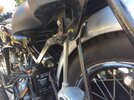Hi
Just doing my clutch and noticed the LH mudguard support strut is broken at the top.
From what I can see, there’s four places the guard is held.
Might have been caused by the the bad roads around here or undue stresses on it somehow.
Maybe could try and weld it if I get a kit or take it to the guy from my local club who fixed the rear number plate bracket.
Is there a decent cheap welding kit that would do the job? Would be handy to have.
Any help appreciated.
Just doing my clutch and noticed the LH mudguard support strut is broken at the top.
From what I can see, there’s four places the guard is held.
Might have been caused by the the bad roads around here or undue stresses on it somehow.
Maybe could try and weld it if I get a kit or take it to the guy from my local club who fixed the rear number plate bracket.
Is there a decent cheap welding kit that would do the job? Would be handy to have.
Any help appreciated.

